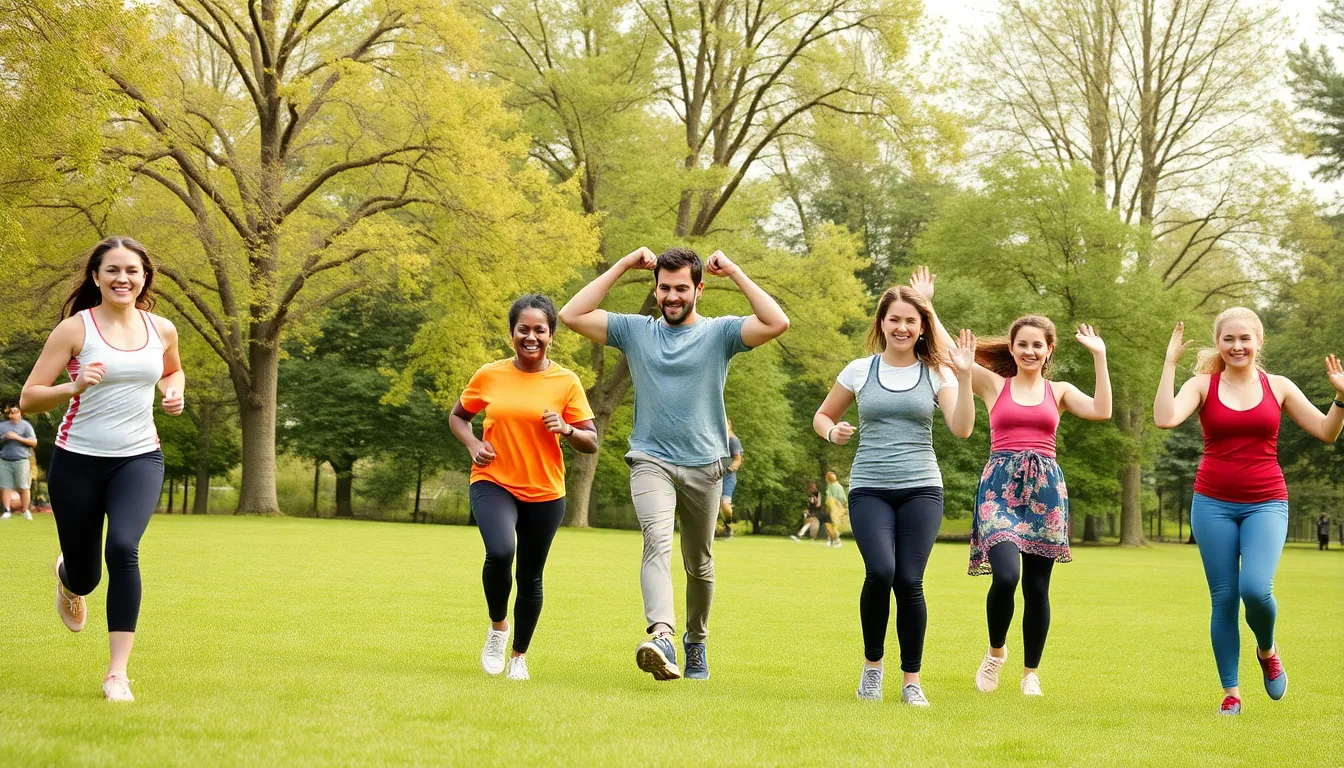In a world where couch cushions often double as workout equipment, the idea of exercise for wellness might seem like a distant dream. But don’t be fooled—getting active isn’t just about sweating it out in a gym. It’s about finding joy in movement and embracing a lifestyle that keeps both body and mind in tip-top shape. After all, who wouldn’t want to trade that sluggish feeling for a burst of energy that makes even Mondays seem bearable?
Exercise isn’t just a chore; it’s a ticket to a happier, healthier life. From dancing in the living room to chasing after kids or even just taking the stairs instead of the elevator, every little bit counts. So grab those sneakers and let’s dive into the fun side of fitness, where wellness meets laughter and every step brings you closer to feeling fantastic.
Table of Contents
ToggleBenefits of Exercise for Wellness
Exercise provides numerous benefits that contribute to overall wellness. Engaging in regular physical activity significantly enhances both physical and mental health.
Physical Health Improvements
Regular exercise boosts cardiovascular health. It lowers blood pressure, reducing the risk of heart disease. Strength training improves muscle tone and increases metabolism. Increased strength aids in daily activities and enhances mobility. Weight management becomes easier through consistent physical activity, promoting a healthy body composition. Exercise also strengthens bones, decreasing the likelihood of osteoporosis. Improved immune system function results from regular movement, leading to fewer illnesses.
Mental Health Enhancements
Mental wellbeing improves with consistent exercise. Physical activity releases endorphins, which help alleviate feelings of stress and anxiety. Increased self-esteem often follows regular exercise, fostering a positive body image. Engaging in group activities or classes enhances social connections, combating loneliness. Cognitive function benefits from physical activity, improving memory and focus. Additionally, exercise promotes better sleep quality, which is vital for overall mental health. Regular movement contributes to a more balanced emotional state, leading to greater happiness and overall life satisfaction.
Types of Exercise for Wellness

Various forms of exercise contribute significantly to overall wellness. Understanding these types can help integrate movement seamlessly into daily routines.
Aerobic Exercises
Aerobic exercises enhance cardiovascular endurance and increase lung capacity. Activities such as running, swimming, cycling, and brisk walking elevate heart rates and improve overall fitness levels. Engaging in these activities for at least 150 minutes weekly provides substantial health benefits. Regular aerobic routines assist with weight management, lower blood pressure, and decrease the risk of chronic illnesses. Exercises like dancing or group classes not only improve endurance but also add an element of fun to the regimen. A mix of high-intensity intervals within aerobic sessions boosts calorie burn and keeps workouts interesting.
Strength Training
Strength training focuses on building muscle mass and boosting metabolism. Lifting weights, using resistance bands, and performing body-weight exercises contribute to stronger and more toned muscles. It is advisable to incorporate strength training into the weekly routine at least two times. This type of exercise strengthens bones, reduces injury risks, and enhances physical performance in daily activities. Additionally, compound movements such as squats and deadlifts engage multiple muscle groups and promote functional strength. A structured approach to strength training, along with adequate recovery, fosters fitness progress and increases overall body stability.
Creating a Balanced Exercise Routine
A balanced exercise routine enhances wellness by combining diverse activities and achievable objectives. This approach fosters consistency, leading to sustainable health benefits.
Setting Realistic Goals
Setting realistic goals serves as a foundation for a successful exercise routine. Establishing specific, measurable targets increases motivation and accountability. For instance, aiming for 30 minutes of activity five days a week allows for achievable consistency. Progressing gradually encourages lasting engagement without overwhelming oneself. Tracking milestones also helps recognize improvements, reinforcing dedication and commitment. In this manner, realistic goals transform exercise from a chore into a rewarding experience.
Incorporating Variety
Incorporating variety into an exercise routine prevents boredom and maintains enthusiasm. Engaging in different activities, such as swimming, cycling, and yoga, stimulates various muscle groups and promotes overall fitness. Alternating between aerobic exercises and strength training ensures well-rounded development. Trying new sports or dance classes introduces excitement and social interaction. Prioritizing diverse workouts not only enhances physical fitness but also contributes to mental well-being, making the fitness journey enjoyable and sustainable.
Overcoming Barriers to Exercise
Overcoming barriers to exercise involves recognizing obstacles and implementing strategies to enable a more active lifestyle. Addressing these challenges directly enhances well-being and promotes consistency.
Time Management Strategies
Effective time management aids individuals in prioritizing exercise. Block out specific times during the week dedicated to physical activity. Exploring fitness apps can help in setting reminders and tracking progress. Short, efficient workouts—like high-intensity interval training—deliver maximum results in minimal time. Integrating exercise into daily routines makes it easier to maintain activity levels. For example, choosing to walk or bike to work contributes to both fitness and time efficiency.
Motivation Techniques
Finding motivation can elevate the exercise experience. Setting clear and achievable goals ignites a sense of purpose. Joining a workout group or fitness class fosters social connections and accountability. Rewarding personal milestones—like completing a month of consistent workouts—creates positive reinforcement. Visualizing success and maintaining a fitness journal can track progress and celebrate achievements. Incorporating music or engaging podcasts during workouts keeps enthusiasm high and workouts enjoyable.
Embracing exercise as a fundamental aspect of wellness can transform lives. By integrating enjoyable activities into daily routines individuals can experience significant improvements in both physical and mental health. The journey toward a healthier lifestyle doesn’t have to be daunting; it can be fun and fulfilling.
Setting achievable goals and maintaining variety in workouts keeps motivation high while overcoming obstacles ensures consistency. With every step taken toward an active lifestyle individuals not only enhance their well-being but also cultivate a deeper sense of happiness and fulfillment. Prioritizing movement is a powerful choice that leads to lasting benefits and a more vibrant life.





